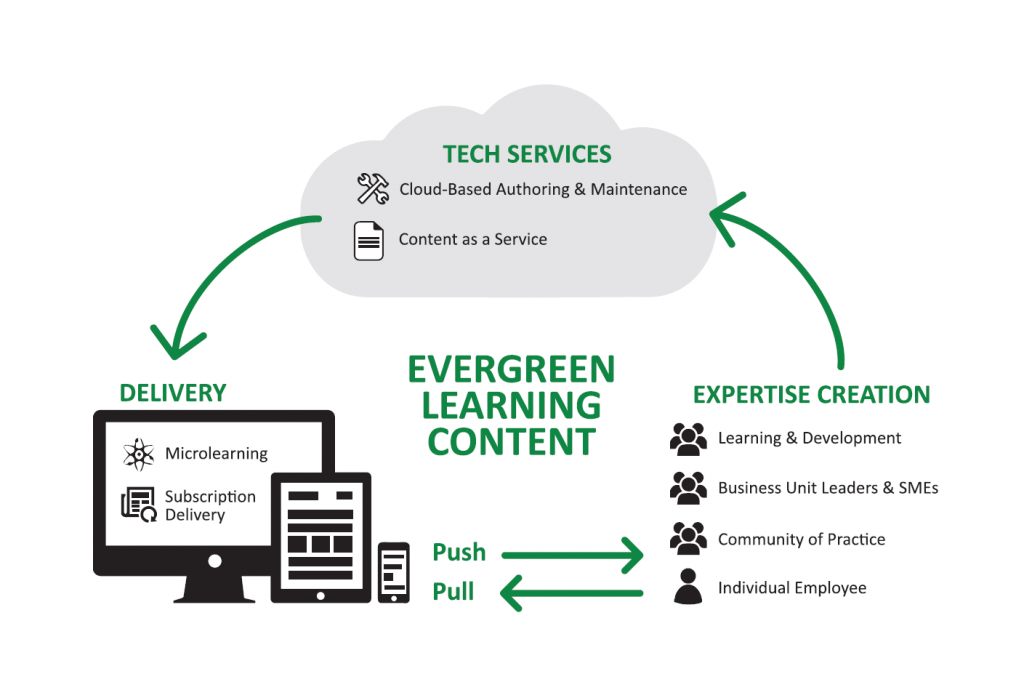What is the shelf life for e-learning? Years, months? If learning leaders could make updates more easily — in real time, for example — what would be the optimum refresh rate?
Typically, the shelf life of e-learning is all about the shelf life of the content itself. Are these policies or best practices dynamic or static? How often do they change? If doing a refresh was somehow easier, perhaps updates for learning efficacy, popularity or demand, relevance, and motivation might displace content variability as the primary motive for making changes.
Part of the problem is that perceived cost and inevitable technology changes drove the need for updates in the past. Because of budget constraints and business demand, a typical learning and development department is more likely to expand new offerings than to optimize those that already exist. When a course no longer works in modern browsers, it’s time for an update or refresh. When a Flash course won’t play on a mobile device — and the mobile device belongs to the head of sales — a redesign may be viable.
For learners, this means the expiration date for a course is set by external factors that don’t have a lot to do with efficacy or performance. The average learning management system is full of stale, outdated and obsolete offerings that will be ignored if they aren’t mandatory. Mandatory programs such as an annual ethics course can contribute to learner fatigue, a dislike of e-learning modalities, and a diminishing reputation for the programs’ sponsor or owner.
Consider your personal sources for online news, pop-culture gossip, or a social media fix. Each visit to one of those websites, offers something new or refreshed so you keep coming back, and make that page a destination. It becomes a resource or tool. Frequently refreshed content is sometimes called evergreen content because small, targeted updates keep the user experience from becoming stale. Creating such a site is good pull marketing because users go back every few days, if not every day, to see what’s going on.

If part of the solution is having easy-to-update content, then the other relevant component is a better delivery model. Compare the usual delivery of e-learning content — one-and-done, annual or “as-needed” — with popular subscription services like BirchBox or the Dollar Shave Club. An auto shipping or subscription model helps ensure that a one-time purchase becomes a routine buying habit. It’s a great push strategy. If changing behavior over the long term is the objective, learning leaders need a better model to delivering their products.
For the past several years, cloud computing has been transforming the way businesses handle servers, storage and applications. This model is still relatively new, however, within the realm of learning and performance. If learning leaders consider the cloud at all, they think of it as a useful strategy for backend technology or next-generation learning management systems. They don’t think of it as a strategy to create content, maintain and refresh instructional assets, or serve them up dynamically based on user preferences, roles or organizational content.
There are two approaches to using cloud technology that have the potential to solve the problem of ever-expiring content:
- Cloud-based authoring and maintenance: Moving authoring and maintenance to the cloud helps create the nimble environment necessary for dynamic, real-time publishing of learning content to the Web. It creates a shared environment, accessible by many, for easy and quick publishing. In addition to supporting learning and development, business unit leaders, subject-matter experts, and even learners and their peers can use smart templates and micropublishing.
- Learning CaaS, or content as a service: Delivering a learning solution using a subscription model entails providing ongoing resources and development based on learner preferences, profiles or corporate initiatives. Learners receive periodic push notifications whenever new or refreshed content becomes available. Web services can also be used to compensate for any learning management system inadequacies.For instance, a learning content service may set a schedule to cover a calendar of microtopics with an expectation that all team members will allocate some portion of their week or month to continuous improvement. The model can be flexible enough to accommodate same-day updates from the CEO, using the same technology that allows for evergreen content on online news sites.
Such a strategy balances the need for formal learning with learner-driven, on-demand resources. These resources can be incorporated as widgets, banner ads or card-style components on a variety of websites outside the LMS.
Imagine delivering the latest sales training directly into the salesforce, or embedding training on ethics directly into an online policy. Better yet, imagine having the ability to refresh or replace that content at any time. Expectations are changing. Soon, it won’t be enough to simply finish a course and publish it to the LMS. Content will need the latest, most valuable information, and it will need to be delivered using a model that is sustainable over the breadth of the performance lifecycle.
Michael Noble is the chief learning officer for AllenComm. Comment below, or email editor@CLOmedia.com.














